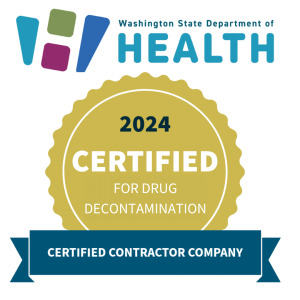Attic ventilation is a critical component to maintaining even temperatures in your attic all year long. In the summer it saves on the life of your shingles by keeping the boards cooler and decreases your cooling costs in the winter weather by diminishing the temperature difference which in turn prevents moisture build up in the form of condensation. Did you know that having a proper amount of attic ventilation is even required to enforce the warranty of most shingle manufacturers?? When it comes to mold the most import ventilation concerns occur in the winter. In the winter during the coldest months as we run our furnaces, hot air escapes into the cold unheated attic space. When the escaping hot air emerges into the cold attic it rises as heat always does. It seeks out the highest portions of the attic where it then coalesces against the cold boards of the roof. This hot- air-mass-meets-cold-surface phenomena results in a condition known as dew point, which creates moisture in the form of water droplets and ice crystals. The nails themselves also will contribute to this moisture problem as iron is a good conductor of temperature and will readily convey the biting chill of cold winter air directly inside the attic. The evidence of this, can be seen in the form of drips and of drip spots underneath the nails themselves.
Bathroom fans vented directly into the attic or Soffit areas rather than straight through the roof are also to blame for exacerbated moisture problems which lead to mold, wood- rot and health problems. The more adults showering in the house and the longer the showers the more moisture will enter an attic. In fact in some families the bathroom fans alone are the sole culprit responsible for major mold infestations! Use your fans for 20min or longer after use!
If you want to eliminate attic mold permanently you NEED to get EQUAL amounts of Intake Air and Exhaust or Out-take Air into your Attic!
Building scientists have proven that using a balanced ventilation system that utilizes equal amounts incoming and out going air. Incoming air comes in from under the eves through vents cut in the underside of the roof overhangs which are called soffets. Proper soffet ventilation is essential to large amounts of incoming air needed for intake. Many attics were originally vented properly but have become packed with insulation along the way by an over-zealous insulation contractor or homeowner, in an attempt to actually stop air from coming in, sadly a common mistake. This mistake was very common in the 80's and 90's. There are two basic types of Soffit vents: either a contiguous vent or a individual vents which come in round and square varieties. I generally prefer to use 6 inch by 12 inch square vents because of the ease of installation and the low material cost. They work surprisingly well and offer a lot of surface area. They can be purchased easily in brown white and silver to match virtually any siding.
Out-take air, exhaust air ventilation can take 4 basic forms: Gable end vents, ridge vents, box/hat vents or power vents. Of the four the ridge vent is to be preferred, due to its location at the highest point of the attic, namely the ridge. Because heat always rises it is passively efficient at exhausting large amounts of heated air without the use of electricity. Be sure to select a ridge vent without a complicated filter which can become clogged; I prefer the simple metal designs for their simplistic efficient design and operation. Box vents while older and more dated can be efficient if there is a sufficient number of them located across the surface. If your attic already has square, can, or box type vents but not enough of them, it can be a less expensive solution to an inadequate exhaust air problem. The reason is simple they are cheap and easy to install and like the square intake vents can be easily purchased in several colors to match any shingle. If you have a hip roof there may be insufficient ridge length to allow for sufficient out-take; box vents can be an ideal solution for this problem. Powered vents work well, but are dependent upon electricity for operation. This both costs money and is subject to wear and tear of moving parts. Additionally in the event of power outages can leave the attic over heated, for these reasons the author does not recommend them.
Beware of mixing two different kinds of ventilation!!!
By far one of the most common, and the most troubling ventilation mistakes is the mixed use of two completely different ventilation systems. For example mixing a ridge vent with a box vent or a previously installed power vent or gable end vents. What goes wrong is this: air always follows the path of least resistance and looks for the nearest opening , often the ridge will draft air from the box vents and short circuit the entire exhaust air systems, eliminating any chance of correcting the water/moisture issues. It can also bring unwanted weather snow debris etc into the attic because box vents and gable end vents were not meant to be intake vents, which can cause tremendous damage! So remember don't mix two ventilation systems pick one and stick with it ensuring there is enough of whatever vent system you choose. Most builder today do not follow this GOLDEN rule!
Is correcting my ventilation a cure for a mold problem in my attic?
NO!! it is not a cure for mold but just for ventilation problems which create moisture issues. No matter who installs your ventilation system in the winter if you are running supplemental heat in your home your attic will be subject to some moisture from time to time during the coldest days. For this reason and several others it is a must to actually treat the mold with a system designed to remove it completely without leaving behind mold or poisonous heavy metals paints and chemicals that can make your family sick. Even dead mold can still affect your health and make your family sick. It is also a good idea to hire a mold contractor with a ventilation expert on staff, because hiring a roofing contractor and a mold contractor is always more expensive!
Removing the moisture
Hot air rises. Without air sealing your attic you are allowing warm air to escape from your home carrying with it your hard earned winter heating money. Most people just add insulation to their attic - this will not stop the escaping warm air. The EPA estimates that the typical American home has enough leaks, holes and gaps to be equal to an open window every day of the year. That is significant. We need to seal the air in our conditioned living space from the unconditioned attic space. Every attic needs proper ventilation. We are not stopping the proper air exchange in the attic - we are only stopping the exchange between the house and the attic.






 Pacific Northwest Inspections Group test for Meth in areas within Public housing neighborhood. PNWIG wondered how far the contamination exposure goes where the Public is unaware. So we decided to test the gas pumps at a local gas station in an area where we frequerntly see meth issues. Does handling these pumps tranfers meth residue? ( Lab Results Pending )
Pacific Northwest Inspections Group test for Meth in areas within Public housing neighborhood. PNWIG wondered how far the contamination exposure goes where the Public is unaware. So we decided to test the gas pumps at a local gas station in an area where we frequerntly see meth issues. Does handling these pumps tranfers meth residue? ( Lab Results Pending )

 e have a lack of test data for meth encaplusation of this product to comment on. Questions of concern are:
e have a lack of test data for meth encaplusation of this product to comment on. Questions of concern are:

 Category 1. "Clean Water" is from a source that poses no substantial harm to people. Water that overflowed while running your bath water, leaking from a supply line for an ice maker, dishwasher or clothes washer are good examples. This assumes that the surfaces being flooded are reasonably clean. Flooding from clean water is usually treated by extracting standing water. Air movers are set up to create evaporation and dehumidifier's to remove the moisture from the air. After 48 hours, a Category 1 can become a Category 2.
Category 1. "Clean Water" is from a source that poses no substantial harm to people. Water that overflowed while running your bath water, leaking from a supply line for an ice maker, dishwasher or clothes washer are good examples. This assumes that the surfaces being flooded are reasonably clean. Flooding from clean water is usually treated by extracting standing water. Air movers are set up to create evaporation and dehumidifier's to remove the moisture from the air. After 48 hours, a Category 1 can become a Category 2. umber of pints per day. On-going equipment use is based on psychrometric calculations to verify adequate and safe drying.
umber of pints per day. On-going equipment use is based on psychrometric calculations to verify adequate and safe drying.









 Bathroom vent fans are required by the NEC (National Electrical Code) and local building codes for any bathroom that doesn't have a window that can be opened to provide ventilation. In some jurisdictions, they are required even if windows are present.
Bathroom vent fans are required by the NEC (National Electrical Code) and local building codes for any bathroom that doesn't have a window that can be opened to provide ventilation. In some jurisdictions, they are required even if windows are present.

 Occupational Health and Safety Administration, OSHA Your first step should be to inspect for any evidence of water damage and visible mold growth.
Occupational Health and Safety Administration, OSHA Your first step should be to inspect for any evidence of water damage and visible mold growth. 






 ven have a scope of work in place.
ven have a scope of work in place.



